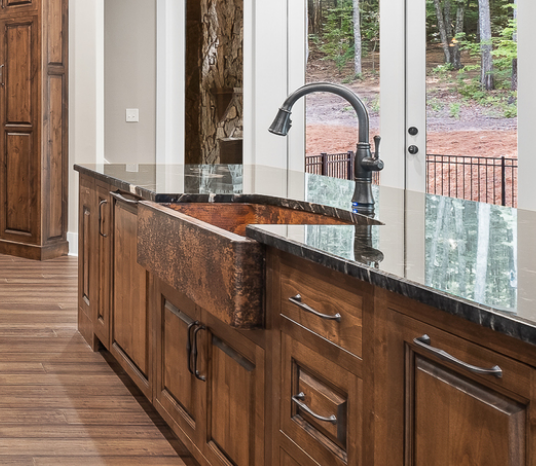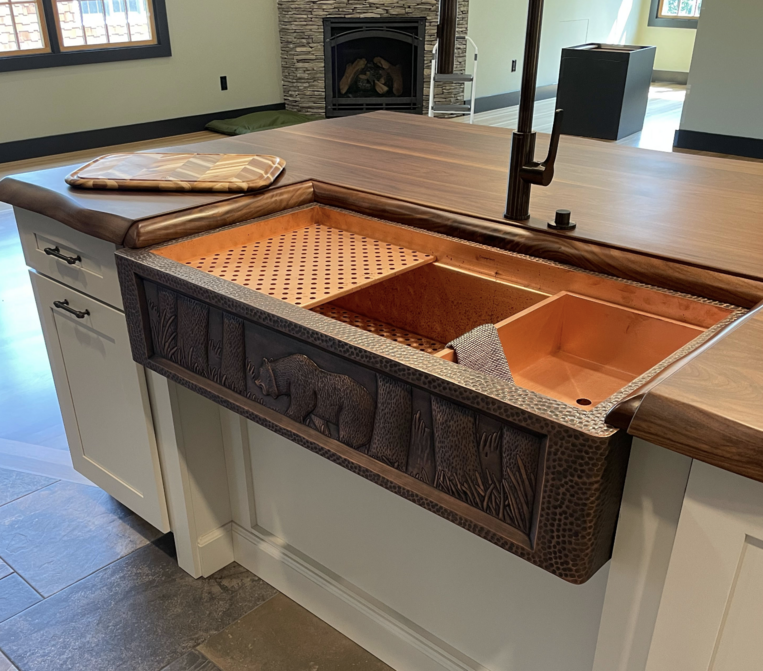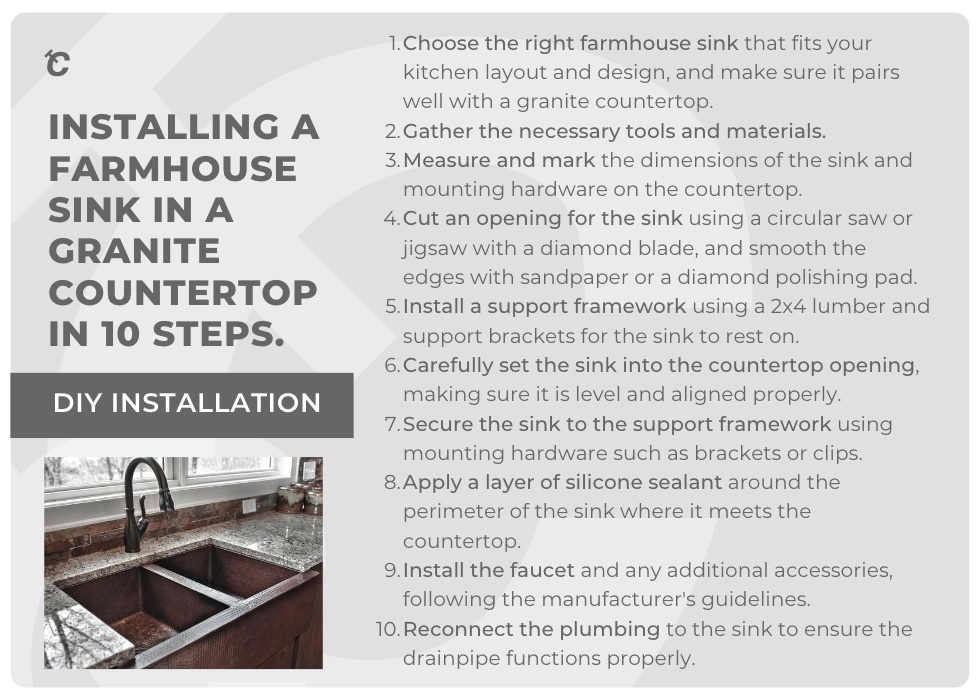Beyond this, however, both products are considered to be highly durable, which means they will stand the test of time. As a result, investing in granite countertops and farmhouse sinks can pay off in the long run, as they’ll become fixtures within your home for years to come - unlike other products, which may need to be replaced every few years.
Another benefit associated with installing farmhouse sinks in granite countertops is, provided you follow the correct instructions, you can install them yourself in just a few hours. This means that unlike with other products, you do not have to factor the cost of installation into your budget - giving you more money to spend on your dream sink and other kitchen features. Furthermore, this gives you the chance to put your DIY skills to the test, which can leave you with a sense of pride and accomplishment each time you step foot into the kitchen!
A farmhouse sink has always been synonymous with a rustic, country-style of the kitchen. A country home, particularly a country-style kitchen, is one that is welcoming and inviting because that is what one thinks of with a country home. It's only been recent that farmhouse sinks have permeated other kitchen designs for homes not located on farms. A farmhouse kitchen adds a touch of charm to a kitchen while also having a timeless appeal that allows it to fit any kitchen style. Then, the addition of a granite countertop with a farmhouse sink upgrades the charm to that of elegance. So, if you'd like to redesign your current kitchen style or are designing a new home, this guide will assist you in choosing A farmhouse sink for your kitchen.
The Installation
1. Choosing the Right Farmhouse Sink
With so many farmhouse sink designs on the market, it can seem overwhelming and challenging to decide on what sink to use for your kitchen. When making your sink decision, we encourage you to choose one that meets your kitchen layout and design and is functional. To choose the right sink, you must also consider the style of the sink, its material, and its size. It's best to assess how well your farmhouse sink pairs with a granite countertop.
More often than not, the choice of which farmhouse sink you should install in your kitchen comes down to personal preference and desired aesthetics. Fortunately, as Farmhouse Sinks are often available in a range of different colors and finishes, it's easy to find a model that matches your tastes, whether you’re looking for something sleek and simple or a little bolder or more unique in appearance.
For example, you could opt for a stainless steel farmhouse sink, which is simplistic and traditional in appearance, meaning it blends easily with other kitchen features, or a ‘textured’ design, such as a Brass-Blackened Farmhouse Sink. When browsing different materials and finishes, you may also want to consider the durability of the materials used.
2. Gathering Tools and Materials
If you were installing a farmhouse sink in your kitchen on your own, you'd need the proper tools and materials. These may include:
- Measuring tape
- Level
- Pencil
- Safety glasses
- Circular saw or jigsaw with a diamond blade
- Clamps
- Drill
- Silicone sealant
- 2x4 lumber
- Support brackets
Once you’ve purchased any tools and supplies you may need, you may also want to take some time to brush up on your DIY skills. After all, doing so will reduce the chances of you making a costly mistake during the installation process. This is particularly important when you consider the fact that the average homeowner in the US has nine unfinished DIY projects on the go at once - often stopping as they lack the necessary skills required to finish the task.
3. Measuring and Marking the Countertop
Everyone knows that you should measure twice when building or installing anything. This ensures that you have taken accurate measurements and even checked yourself to ensure you're correct. When installing a farmhouse sink in your kitchen, your measurements need to be exact. You must measure your sink’s width, depth, and height and mark the dimensions on your countertop accordingly. Don't forget to take into account the space you will need for not only the sink but also the sink mounting hardware, including any additional accessories like a new faucet or soap dispenser.
Cutting and Preparing the Countertop
1. Cutting the Sink Opening
Once you've written down your accurate measurements, you are ready to begin cutting and preparing your countertop. (This only applies to existing countertops that have no opening.) you will need to use a circular saw or jigsaw with a diamond blade to cut an opening for the sink into your granite countertop. Remember, whenever you are using power tools, safety comes first. So be sure to wear safety glasses and follow proper procedures when using the jigsaw.
2. Smoothing the Edges
Once the sink opening has been cut, you must smooth any rough edges around the opening using fine grit sandpaper or a diamond polishing pad. This will ensure that there are no snags on the granite and that there is no damage to the sink once you've installed it.
3. Creating a Support Framework
Farmhouse sinks are heavy and require extra support once they've been installed. So, you will need additional help to hold up the sink's weight. A two-by-four piece of lumber is often attached inside the cabinet underneath the farmhouse sink to hold it secure. You will then have to install support brackets under the countertop for stability. This ensures the sink does not fall out and land within the cabinetry under its opening.
Installing the Farmhouse Sink
1. Setting the Sink
Now that you have been prepped with the steps you'll have to take to install your farmhouse sink, you are ready to do the installation. This will be a two-person job. Once you've removed the sink from its packaging, you must carefully set it into the countertop opening. Be sure that once you have set it into the countertop opening, it is leveled and adequately aligned within the cutout.
2. Securing the Sink
Secure the sink to the support framework using appropriate mounting hardware, such as brackets or clips. You'll need to secure this sink using the mounting hardware provided in the packaging, which are brackets or clips. If your sink does not happen to include mounting hardware, you must consult with the manufacturer’s guidelines for an alternate way of installing your sink so that the framework is supported. If your sink does not include mounting hardware, consult the manufacturer's policies for proper installation techniques.
3. Sealing the Sink
Once the sink is secure and the framework has been mounted, you are now ready to apply a layer of silicone sealant around the perimeter of the sink. This area will be the area where the sink and the granite countertop meet. This silicone sealant creates an airtight and watertight seal, which is critical to installing a farmhouse sink. This water-tight seal will prevent water from seeping between the sink and the countertop Preventing mold from growing, and also an unsupported sink and framework.
Finalizing the Installation
1. Installing the Faucet and Accessories
Once your farmhouse sink is securely in place, you can pat yourself on the back and breathe a deep sigh of relief. You're now ready to install the faucet for your farmhouse sink and any additional accessories you may have, like a soap dispenser or garbage disposal. Refer to the manufacturer's guidelines for adequately installing these items, and ensure they are fastened on the countertop.
2. Connecting Plumbing
Next, the plumbing will need to be reconnected to your farmhouse sink to ensure that the drainpipe and water supply lines are running correctly. Be sure that all the connections have been screwed in tightly and that they are leak free. You will need to do a test by turning on the water from your faucet and checking for any leaks or significant issues. Reconnect the plumbing for the sink, including the drainpipe and water supply lines. Ensure all connections are tight and leak-free. Test the sink by running the water and checking for leaks or issues.
3. Cleaning and Maintenance
Now, you have reached the final step. Take a step back and smile at your hard work. You've completed your farmhouse sink installation, and you are now ready for the final touch, which is to clean your sink and the surrounding area to remove any debris or residue like dust, dirt, or even silicone smudges.
Regularly maintaining your farmhouse sink and granite countertop by cleaning it will be something you will gladly do because you will want to preserve its beauty and longevity.
Mistakes to avoid when Installing a Farmhouse Sink in A Granite Countertop.
While the above guidelines are useful in ensuring your renovation project is a success, you should also be wary of the common mistakes people make when carrying out this task - so that you are able to avoid them moving forward.
-
Taking incorrect measurements.
Inaccurate measurements of the sink, fixtures, or the space you have available to you within your kitchen can lead to disaster during a DIY project. After all, it could mean that you purchase a product that is the wrong size, meaning it will not actually work as designed. As such, it's crucial that you double (or even triple) check your workings before placing an order.
-
Rushing.
Whether you’re excited about bringing your new vision for your kitchen to life or putting your new DIY skills to the test, it's important that you do not rush the installation process. This is due to the simple fact that it could impact your ability to focus, meaning you’re more likely to make mistakes. Instead, set aside a few hours of your day that you can dedicate to this task. Remember, slow and steady wins the race!
-
Disregarding health and safety practices.
While the process of installing your own farmhouse sink in a granite countertop is simple and stress-free (which may be one of the reasons why they are such a popular kitchen combo), you should always ensure you act with health and safety in mind. After all, this will help to prevent accidents and injuries and reduce the chances of you damaging the sink or other fixtures in your home during the process.
Although installing a farmhouse sink may have seemed like quite a feat and even a daunting task initially, you've done it!
Congratulations! Many DIYers like yourself see this as quite an accomplishment. Your farmhouse sink will be something you will enjoy in your kitchen for many years for its durability, functionality, and style.









